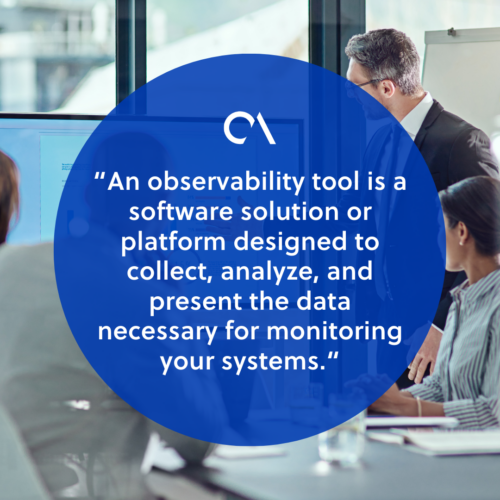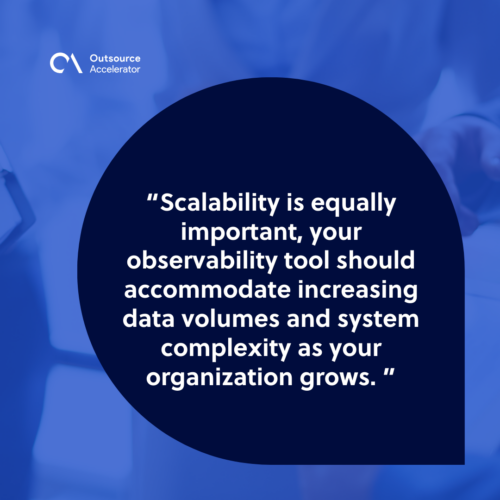10 observability tools to help monitor your systems

List of 10 observability tools
- Microsoft Azure
- Amazon Web Services
- Datadog
- Dynatrace
- ScienceLogic SL1
- GitLab
- Auvik
- Splunk IT Service Intelligence
- LogicMonitor
- New Relic
Understanding system behavior also supports effective root cause analysis when problems arise.
It allows organizations to trace issues back to their source and implement long-term solutions rather than applying quick fixes that may introduce new problems.
Moreover, monitoring provides invaluable data for performance optimization. It helps identify areas where efficiency can be improved, enhancing user experiences, reducing operational costs, and competitive advantages.
These are all made possible through the use of observability tools.
What is an observability tool?
An observability tool is a software solution or platform designed to collect, analyze, and present the data necessary for monitoring your systems. It encompasses visibility into various applications, services, and infrastructure components.
Its primary goal is to provide a comprehensive view of your system’s inner workings so that you can effectively identify and resolve issues and track performance.
Observability tools use a combination of metrics, logs, traces, and other data sources to create a holistic view of your IT system environment.

Benefits of an observability tool
Using observability tools has various benefits for organizations and IT teams. Let’s explore some of these key advantages:
Issue detection and resolution
Observability tools provide real-time insights into your systems, allowing you to detect issues and anomalies quickly. By identifying problems early, you can proactively address them, minimizing downtime and user disruptions.
Performance optimization
Understanding how your systems perform in real-world conditions is crucial for optimization.
Observability tools help you pinpoint bottlenecks, resource constraints, and areas where performance can be enhanced, leading to better user experiences.
Root cause analysis
Observability tools help you analyze root causes effectively when issues arise.
By correlating data from different sources, you can determine the exact source of a problem and take appropriate corrective actions.
Scalability and capacity planning
Observability tools provide insights into resource utilization and system load. This data is invaluable for capacity planning and ensuring that your systems can scale to meet growing demands.
Data-driven decision-making
Observability tools make decisions based on real data and insights rather than assumptions. This leads to more informed and effective decision-making, reducing the risk of making changes that may negatively impact the system.
Compliance and security
Observability tools can help you monitor and maintain compliance with industry regulations and security standards. You can ensure data integrity and security by tracking access and changes to your systems.
How to choose the right observability tool
Choosing the right observability tool is a critical decision that demands careful consideration.
Here are a few key points you can follow to make an informed choice:
- Evaluate your specific needs and existing infrastructure.
- Consider the data sources the tool supports, ensuring compatibility with your technology stack, whether cloud-based, on-premises, or hybrid. It should also seamlessly integrate with your existing monitoring and management systems for efficient operations.
- Next, assess the data collection method employed by the tool, opting for a minimally invasive and efficient approach
- You should check if the observability tool caters to data storage and retention as it dictates how long historical data will be available for analysis and decision-making.
- Scalability is equally important, your observability tool should accommodate increasing data volumes and system complexity as your organization grows.
- Robust alerting and notification mechanisms should be in place to promptly inform you of issues or anomalies.

10 best observability tools to try in 2024
Now that we’ve covered the fundamentals of observability tools and what to consider when choosing one, let’s delve into our list of the top ones to consider in 2024.
Each tool on this list has its unique features and strengths. In no particular order, here is our list of the top ten observability tools:
1. Microsoft Azure
Microsoft Azure Monitor is one of the comprehensive observability tools designed for monitoring and managing resources within the Azure cloud environment.
It provides real-time insights into the performance and health of Azure applications and infrastructure.
Microsoft Azure Monitor includes Application Insights, enabling application performance monitoring and diagnostics, as well as infrastructure and platform-level monitoring.
It seamlessly integrates with Azure Log Analytics for in-depth log data analysis. Users can set up custom telemetry data collection and create alerts based on specific conditions.
This makes it a versatile choice for organizations utilizing Azure cloud services.
Features
- Provides comprehensive monitoring and diagnostics for Azure resources
- Includes application insights for application performance monitoring
- Offers infrastructure and platform-level insights
- Integrates with Azure Log Analytics for log data analysis
- Supports custom telemetry data and alerts
2. Amazon Web Services
AWS CloudWatch is Amazon Web Services’ monitoring and observability service tailored for AWS resources and applications.
It features customizable dashboards, enabling users to visualize data and create alarms based on predefined thresholds. It also offers automated scaling and resource optimization.
This is one of the observability tools that play a crucial role in ensuring the operational efficiency of AWS-based environments through monitoring and alerting capabilities.
Features
- Monitors AWS resources and applications on the AWS cloud
- Collects and tracks metrics, logs, and events
- Offers customizable dashboards for visualizing data
- Provides automated scaling and resource optimization
- Integrates with various AWS services
3. Datadog
Datadog is among the highly popular observability tools offering real-time infrastructure and application monitoring. It provides out-of-the-box integrations with an extensive list of technologies, making it suitable for diverse technology stacks.
Datadog has advanced features like anomaly detection, alerting, and event correlation. It also supports log management and Application Performance Monitoring (APM), allowing organizations to troubleshoot and optimize their systems.
Further, Datadog’s custom dashboards empower users to tailor their observability solutions to specific needs.
Features
- Offers real-time monitoring of infrastructure and applications
- Provides out-of-the-box integrations with numerous technologies
- Includes anomaly detection and alerting capabilities
- Supports log management and APM (Application Performance Monitoring)
- Enables custom dashboard creation
4. Dynatrace
Dynatrace is an AI-powered observability platform that excels in automatic problem detection and real-time monitoring of user experience, applications, infrastructure, and cloud services.
It offers automatic baselining for performance comparisons and detailed code-level analysis to pinpoint issues.
Dynatrace is especially valuable for organizations practicing DevOps and continuous delivery, as it integrates with the CI/CD pipeline. This allows for performance monitoring throughout the software development lifecycle.
Features
- AI-powered observability platform for automatic problem detection
- Monitors user experience, applications, infrastructure, and cloud services
- Offers automatic baselining for performance comparisons
- Provides detailed code-level analysis for troubleshooting
- Supports continuous delivery and DevOps practices
5. ScienceLogic SL1
ScienceLogic SL1 is a unified IT monitoring and Artificial Intelligence for IT Operations (AIOps) platform providing real-time infrastructure and application visibility.
It incorporates root cause analysis and event correlation, making identifying and addressing issues easier. This is one of the observability tools well-suited for organizations operating in hybrid and multi-cloud environments.
Features
- Offers unified IT monitoring and AIOps
- Provides real-time visibility into infrastructure and applications
- Includes root cause analysis and event correlation
- Supports hybrid and multi-cloud environments
- Offers customizable dashboards and reporting
6. GitLab
GitLab is primarily known as a DevOps and version control platform, but it also offers monitoring and observability features through integration with other tools.
It combines continuous integration and delivery (CI/CD) with monitoring capabilities. This suits organizations that want to unify their development and operations activities.
While not as specialized as other observability tools, GitLab enables collaboration and end-to-end visibility across development and operations teams.
Features
- Primarily a DevOps and version control platform
- Provides built-in continuous integration and delivery (CI/CD) capabilities
- Offers monitoring and observability features via integration with other tools
- Supports error tracking, performance monitoring, and security scanning
- Enables collaboration across development and operations teams
7. Auvik
Auvik specializes in network monitoring and management, providing real-time network mapping and visibility.
It is an essential tool for IT professionals responsible for maintaining the health and security of network infrastructures, especially in complex and dynamic environments.
Features
- Specializes in network monitoring and management
- Offers real-time network mapping and visibility
- Provides network performance and traffic analysis
- Supports automation of network tasks
- Includes alerting and reporting for network health
8. Splunk IT Service Intelligence
Splunk ITSI is a part of the broader Splunk platform, focusing on IT and service monitoring.
This is one of the observability tools that leverage predictive analytics and machine learning to detect anomalies, providing service-centric views for root cause analysis.
It integrates with various data sources and applications, making it a versatile choice for organizations seeking insights from various data types and domains.
Features
- Part of the larger Splunk platform for data analysis
- Focuses on IT and service monitoring
- Offers predictive analytics and machine learning for anomaly detection
- Provides service-centric views for root cause analysis
- Supports integration with various data sources and applications
9. LogicMonitor
LogicMonitor is a SaaS-based observability tool designed for infrastructure and application monitoring. It supports hybrid and cloud environments, automated alerting, intelligent dashboards, and built-in data visualization.
LogicMonitor is known for its pre-built monitoring templates for popular technologies, simplifying the setup and configuration of monitoring for various systems and applications.
Features
- Provides SaaS-based infrastructure and application monitoring
- Supports hybrid and cloud environments
- Offers automation and intelligent alerting
- Includes built-in data visualization and reporting
- Provides pre-built monitoring templates for popular technologies
10. New Relic
New Relic is one of the best application and infrastructure performance monitoring observability tools.
This observability tool supports integrations with various platforms and technologies, making it valuable for organizations seeking to optimize application performance.
Features
- Specializes in application and infrastructure performance monitoring
- Offers APM, infrastructure, and mobile application monitoring
- Provides real-time insights into application behavior
- Includes anomaly detection and alerting
- Supports integrations with various platforms and technologies







 Independent
Independent




